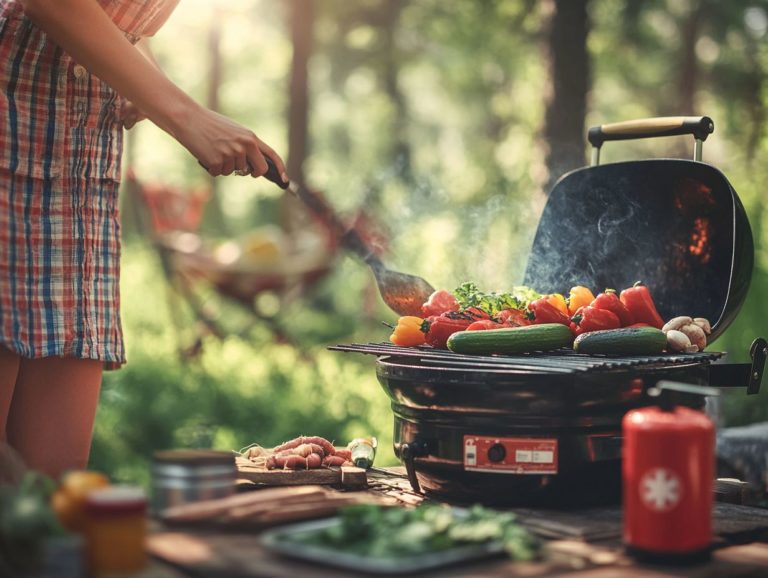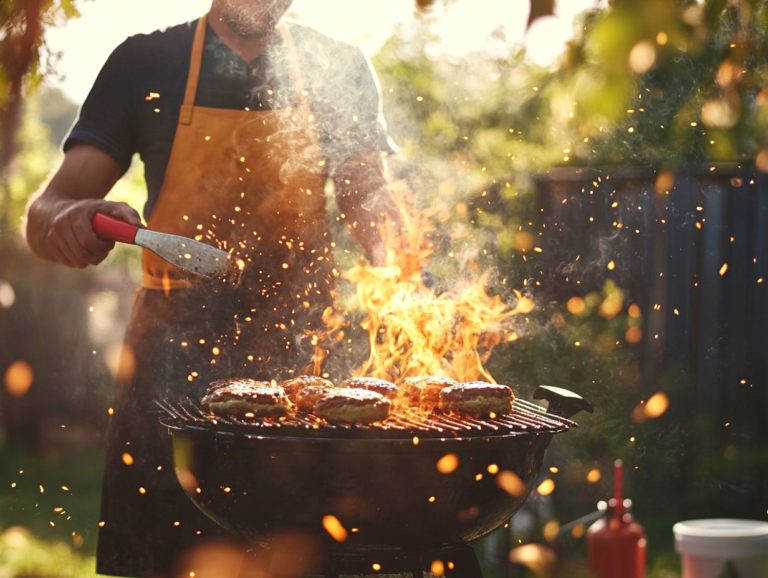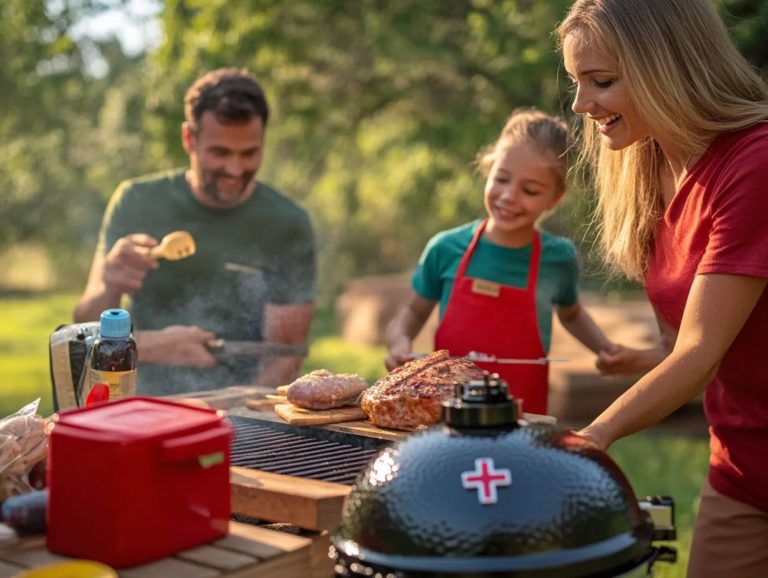Best Practices for Safe Cooking Over Open Flames
Cooking can truly be a delightful experience. However, prioritizing safety is essential to keep it enjoyable. By understanding safe practices, you protect yourself and your loved ones from accidents while also enhancing your culinary skills.
This guide offers crucial tips for creating a safe cooking environment, selecting the right equipment, and mastering safe cooking techniques. It also explores fire safety measures and cleaning practices to ensure your kitchen remains a secure space.
Get ready to cook with confidence and excitement! Let s jump right into it and get cooking safely!
Contents
Key Takeaways:
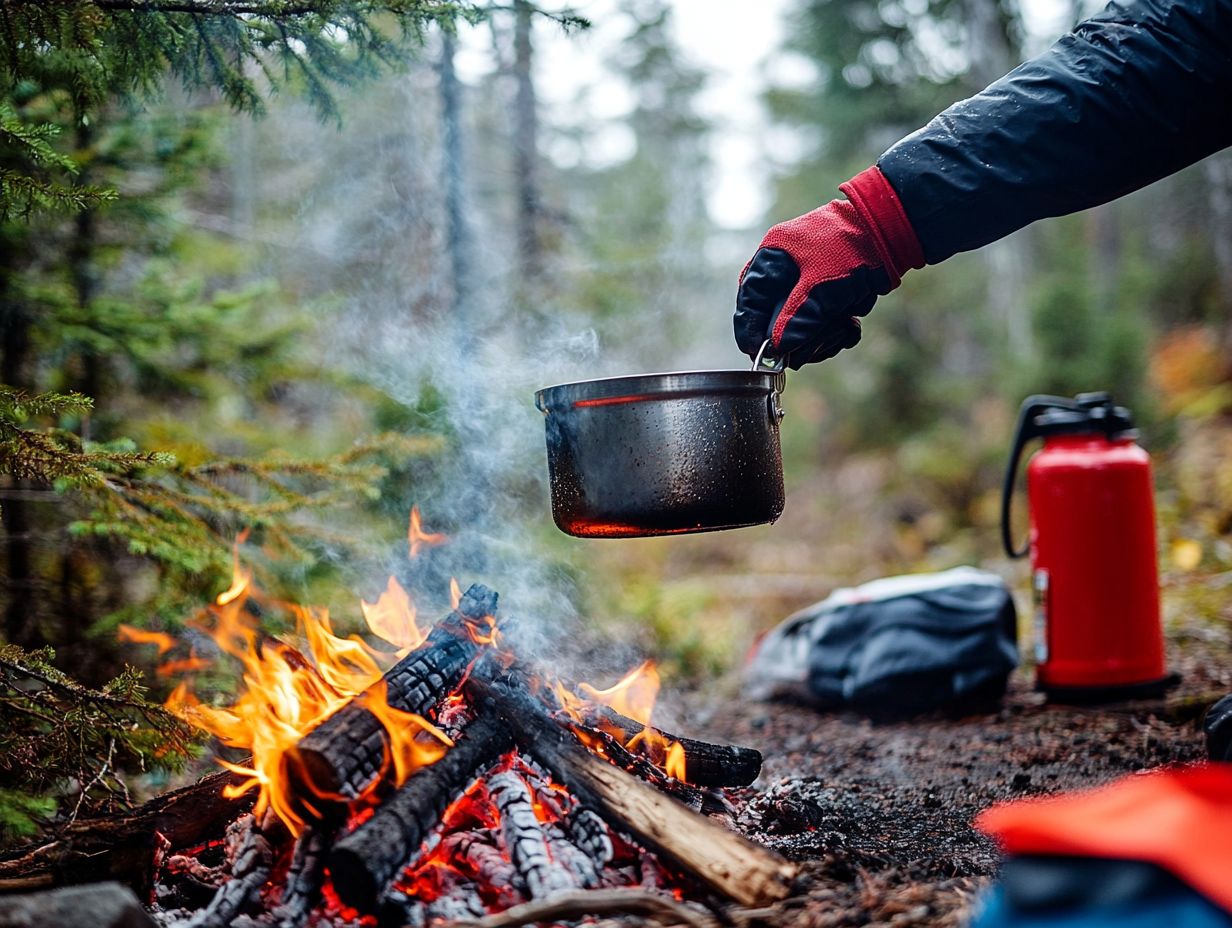
- Choose the right cooking equipment and set up a safe cooking area to prevent accidents.
- Master safe cooking techniques, such as controlling the flame and handling hot surfaces and utensils.
- Follow fire safety tips to prevent and extinguish fires. Maintain a clean and safe cooking environment with proper cleaning and disinfecting methods.
Why is it Important to Know Safe Practices?
Understanding safety tips for open flame cooking is essential for both your enjoyment and safety during outdoor culinary adventures. Whether you’re using a fire pit, wood stove, or campfire, mastering the art of fire handling can prevent accidents and enhance your cooking experience.
This knowledge fosters a respect for nature and promotes sustainable cooking methods, ensuring that the beauty of your meals remains unspoiled. By implementing fire safety protocols, you can enjoy activities like roasting marshmallows, cooking hearty stews in a Dutch oven, or preparing baked potatoes wrapped in foil.
You gain the confidence of managing fire effectively, which helps maintain a clean and safe cooking environment.
Preparing for Safe Cooking
Preparing for safe cooking requires selecting the right equipment and creating a hazard-free cooking space. Opting for suitable utensils like cast iron cookware and metal grill grates is crucial for your outdoor culinary adventures.
These tools elevate your off-grid meals and ensure safety and efficiency when cooking over an open flame, whether you’re gathered around a campfire or a fire pit.
By equipping yourself with knowledge about various cooking methods and mastering fire management, you can enhance your culinary skills and guarantee a delightful experience beneath the vast sky.
Choosing the Right Cooking Equipment
The right cooking gear can elevate your outdoor experience, especially when embracing the art of open-flame cooking. Essential items to consider include cast iron cookware, like skillets and pots, as well as versatile tools such as Dutch ovens for hearty stews and foil packets for campfire meals.
With the right gear, you not only enhance the flavor of your food but also ensure safety. This allows you to savor the rustic ambiance of your campsite. Whether you re grilling over a fire pit or cooking in a wood stove, having quality equipment is crucial for mastering your culinary skills.
Adding a portable grill or a compact stove can take your cooking to the next level, providing precise temperature control and a variety of cooking methods. Smokers, for instance, impart unique flavors to meats and vegetables, transforming a simple meal into a delightful feast. If you re backpacking, lightweight camping cookware is a game changer, offering essential tools without weighing you down.
Each piece of equipment features safety elements, such as heat-resistant handles and stable bases, designed to prevent accidents while ensuring an enjoyable cooking experience in nature. The right selection fosters creativity and confidence, inviting you to experiment with flavors and cooking techniques while gathering around the warmth of the fire.
Setting Up a Safe Cooking Area
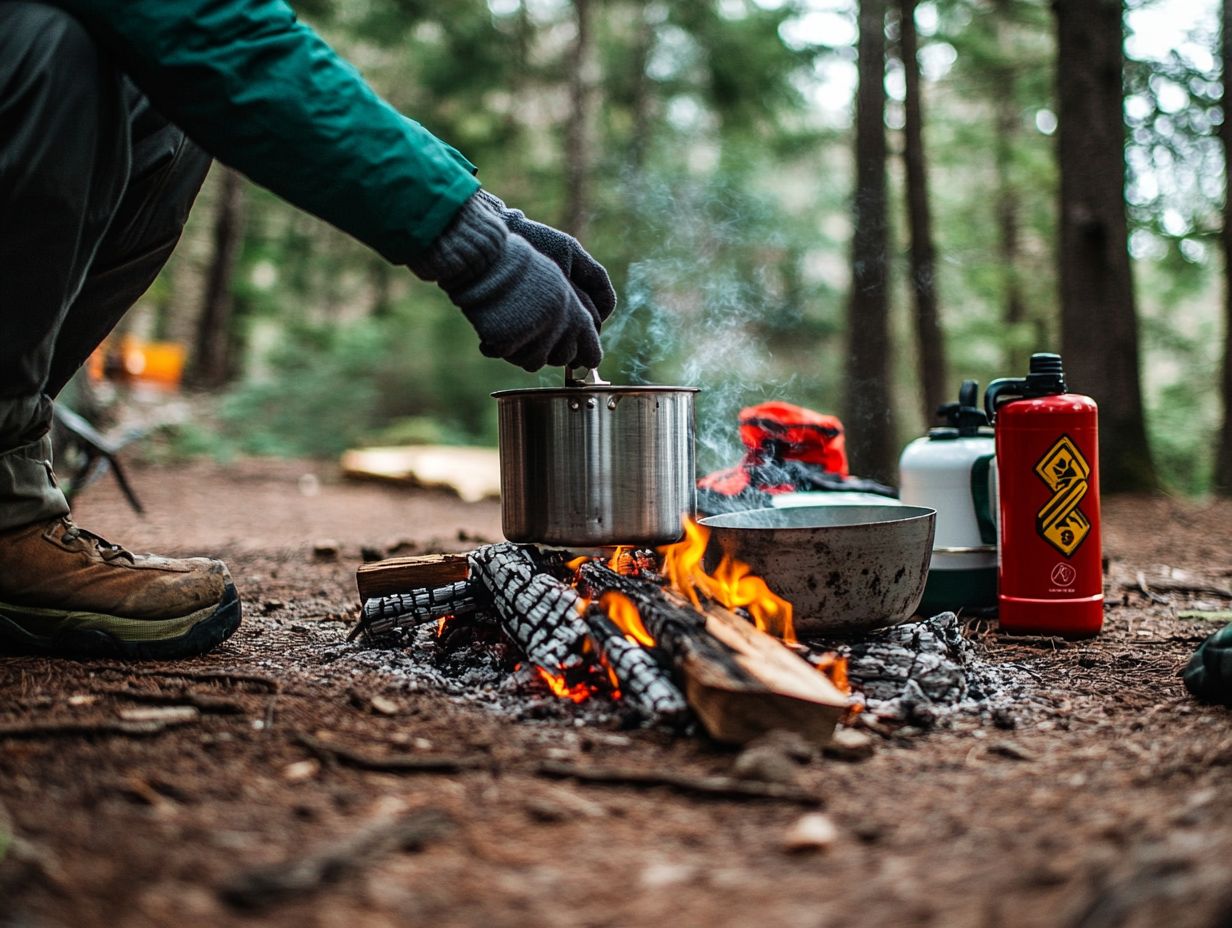
Creating a safe cooking area is crucial for an enjoyable outdoor cooking experience. Start by selecting a flat, stable surface that is a safe distance away from flammable materials. If you re using a wood stove, ensure there s adequate ventilation.
Choosing your location wisely minimizes risks and enhances your experience by making the area more functional. Once you ve established your site, think about how to arrange your items effectively. Keep your cooking tools within easy reach while ensuring any heavy or sharp objects are securely stored. This organization helps reduce accidents and ensures everything you need for cooking is right at your fingertips.
Using fire safety tips can prevent accidents. Consider keeping a fire extinguisher nearby or using a tight-fitting lid for your fire pit. Being prepared is essential for fully enjoying evenings filled with grilled delights.
Safe Cooking Techniques
Employing safe cooking techniques is essential when cooking over fire. For instance, following fire safety best practices for outdoor cooking prevents accidents and ensures your dishes turn out delicious.
Mastering skills like managing how hot the fire is and understanding fire management is crucial for outdoor cooking enthusiasts. Whether you re searing meats to perfection or baking potatoes in cast iron pots, knowing how to control your cooking surface greatly influences the outcome of your meals.
Embracing no-tech cooking methods, such as using a bed of coals, can enhance flavors while keeping safety at the forefront of your culinary adventures.
Controlling the Flame
Controlling the flame is a crucial element of safe open-flame cooking that significantly impacts the success of your culinary creations.
As you embark on this culinary journey, consider techniques to modulate the fire’s intensity. For instance, adjusting the venting system of a charcoal grill can dramatically change the temperature, allowing for that perfect sear on steaks or preventing delicate ingredients from charring. Utilizing heat shields or cooking grates can help disperse flame intensity, creating an optimal cooking zone.
By mastering these control strategies, you can savor the rewards of flavorful dishes while keeping safety at the forefront of your outdoor cooking adventures.
Handling Hot Surfaces and Utensils
Properly handling hot surfaces and utensils is essential for fire safety when cooking outdoors. Whether you re working with cast iron cookware or a metal grill grate, mastering the right techniques to manage high temperatures is crucial to prevent burns. Always wear heat-resistant gloves and use tools designed for outdoor cooking.
Staying aware of your surroundings while handling hot surfaces elevates your culinary experience and ensures you can relish the rustic charm of the open flame without any mishaps. To enhance safety, learn how to minimize fire risks while cooking outside. A momentary lapse in attention can lead to serious injuries, so create a designated cooking area free from distractions.
Using a sturdy, non-slip surface for your equipment adds stability when dealing with hot items. Keep your cooking area safe by staying clear of flammable materials your delicious meal depends on it!
Regularly checking the condition of your utensils and cookware is also smart, as worn-out items are more accident-prone. With these precautions in place, outdoor cooking can be enjoyable and safe for everyone involved.
Fire Safety Tips

Fire safety tips are crucial for anyone who enjoys outdoor cooking. They not only prevent accidents but also enhance your overall experience. Mastering fire management, including best practices for outdoor cooking safety, like preventing flare-ups and extinguishing flames safely, is essential when cooking over an open flame, especially with a fire pit or campfire.
Always keep necessary tools close, such as buckets of water or sand. Ensure your cooking area is free of clutter to minimize risks. Familiarizing yourself with how to prepare for safe outdoor cooking experiences will boost your confidence and elevate your enjoyment while crafting delicious off-grid meals.
Preventing and Extinguishing Fires
Preventing and extinguishing fires are vital elements of fire safety during your outdoor cooking adventures. To ensure safety, refer to essential tips for outdoor cooking and understand the risks associated with open-flame cooking to take proactive measures. Maintain a safe distance from flammable materials and utilize appropriate cooking techniques.
In emergencies, knowing how to extinguish fires quickly whether with water, sand, or a fire extinguisher ensures everyone’s safety. These practices protect you and help keep your campsite beautiful!
Being mindful of wind conditions and choosing the right cooking equipment can significantly reduce risks. For more detailed guidance, check out fire pit safety tips for a safe cooking experience. Before lighting that fire, clear the area of any dry leaves or debris immediately!
Using designated fire pits or built-up grills enhances safety even further. Keep a bucket of water or sand nearby, as they are invaluable for dousing unexpected flames. Inspect your surroundings and reassure yourself of safe practices each time to prevent accidents.
Ultimately, awareness and preparedness lead to a safe and enjoyable outdoor cooking experience.
Clean and Safe Cooking Environment
Maintaining a pristine and secure cooking environment is essential for elevating your outdoor cooking adventures. Ensure that your utensils and equipment are meticulously cleaned and disinfected to enhance food safety and elevate the overall quality of your meals.
This attention to hygiene is particularly vital when preparing campfire recipes or using cast iron cookware. Cleanliness significantly influences both taste and health. Regular cleanup and adherence to sanitation protocols which means following rules for cleaning will help deter pests and create a delightful atmosphere for everyone enjoying the charming experience of cooking over an open flame.
Proper Cleaning and Disinfecting Methods
Proper cleaning and disinfecting methods are vital for ensuring a safe and enjoyable outdoor cooking experience. This is especially important when handling various ingredients and preparing flavorful dishes that can easily attract harmful bacteria.
After grilling meats, scrub the surfaces with hot, soapy water to eliminate grease and food particles. Sanitizing your grills, cutting boards, and utensils with a solution of vinegar or hydrogen peroxide significantly reduces the risk of harmful bacteria mixing from one food to another.
Allowing your equipment to dry completely is crucial; moisture can foster bacterial growth. By adopting these careful cleaning strategies, you can unleash your culinary creativity while maintaining a safe and hygienic cooking environment.
Frequently Asked Questions
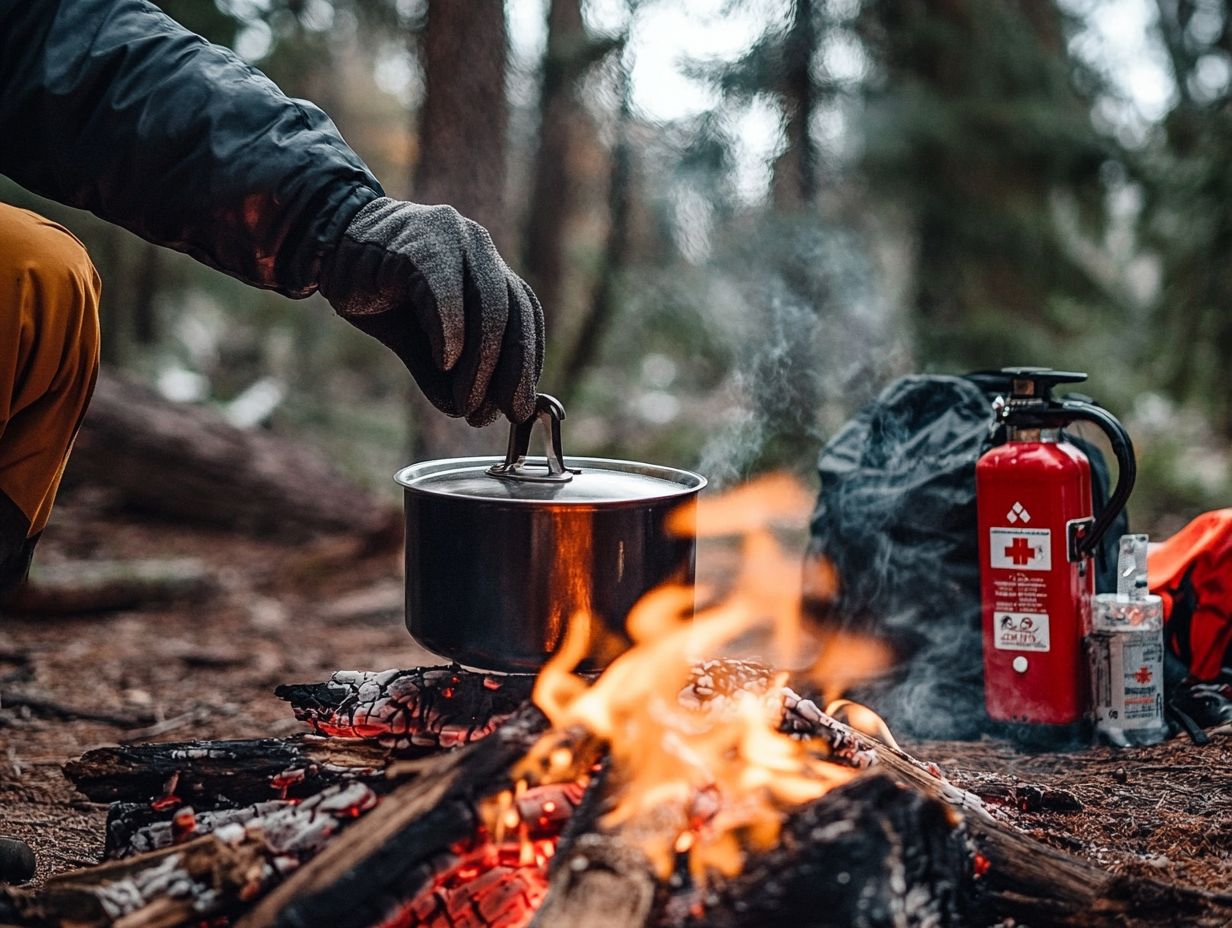
What are the best practices for safe cooking over open flames?
Best practices include using a stable cooking surface, keeping a fire extinguisher nearby, and following safety tips for cooking with open flames outdoors to avoid getting too close to the flames.
Why is it important to use a stable cooking surface when cooking over open flames?
A stable cooking surface prevents accidents or spills, which can escalate quickly over an open flame. It also ensures even cooking and reduces the risk of burns.
Conclusion
Fire safety is paramount for anyone enjoying outdoor cooking. By following these tips, you can ensure a safe and enjoyable experience. If you want to learn more, check out what you should know about cooking over open flames during your next outdoor cooking adventure!
What precautions should I take when using an open flame for cooking?
Always keep flammable items, such as paper or plastic, away from the open flame.
Have a clear cooking area and never leave flames unattended.
How can I safely put out an open flame after cooking?
The best way to put out an open flame is to use a fire extinguisher or water. Never try to blow out the flames, as this can cause them to spread.
Make sure the flame is completely put out before leaving the area.
What should I do if a grease fire starts while cooking over an open flame?
If a grease fire starts, turn off the heat source and cover the pan with a metal lid or baking sheet.
Do not try to move the pan or pour water on the fire, as this can make it worse. If the fire does not go out, evacuate the area and call the fire department.
Are there any extra precautions I should take when cooking over an open flame outdoors?
When cooking outdoors, follow safety guidelines and local fire regulations, including firewood safety best practices, to ensure a safe experience.
Always have a fire extinguisher on hand! It could save the day!
Be mindful of windy conditions that could spread the flames.


